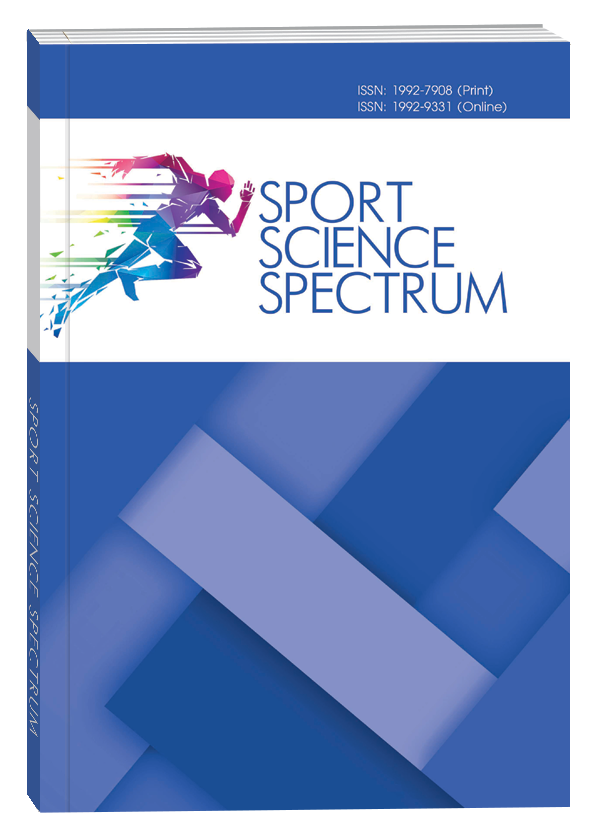SELF-ASSESSMENT OF THE PROFESSIONAL AND APPLIED TRAINING INDICATORS OF MILITARY PERSONNEL IN WARTIME
DOI:
https://doi.org/10.32782/spectrum/2024-2-16Keywords:
professional and applied training, military personnel, response, decision-making, leadership qualities, medical assistance skills, shooting, survivalAbstract
Introduction. The efficacy of combat operations is contingent upon the extent of knowledge and the advancement of professional and applied competencies among military personnel. An understanding of the strengths and limitations of a servicemember’s personality, as well as their skills, can facilitate enhanced task performance and ensure safety. Recent research on the professional and applied training of military personnel has identified several key areas for focus, including the retention of qualified personnel, the development of digital technology skills, diversity initiatives, the enhancement of education levels, leadership development, and support for the transition to civilian life. The purpose of the study is to examine the self-assessment of psychological and special characteristics of vocational training of servicemen of different ages and genders in wartime. The study employed a variety of methods, including the analysis of specialized scientific literature, comparison, surveys, systematization, and statistical analysis. The statistical analysis included a verification of the data for compliance with the normal distribution law (Kolmogorov-Smirnov test), descriptive statistics (central tendency and dispersion Me (25; 75) units), and a set of χ2 criteria (for checking the uniform distribution in the general sample; for independent samples if all variables in the contingency table exceed 5, otherwise, the Fisher exact test was used). A comparative analysis of military personnel indicators with regard to gender and age was conducted using the Mann-Whitney U test. In order to ascertain the p-value through the Mann-Whitney U test, the Z statistic was calculated as the standard deviation of the difference in rank sums from their expected value, divided by the standard deviation. The level of statistical significance was set at p < 0.05. Contingent. The study involved 4,403 military participants and was conducted over the course of 6 weeks, from February 27 to April 15, 2024. Among the participants, 89.9% were male, with 28.9% falling within the 21-30 age range, 28.75% within the 31-40 age range, and 24.9% within the 41-50 age range. The remaining participants were military personnel under the age of 20 or over the age of 50. Of the individuals who participated in the survey, 56.2% were enlisted personnel, and 69% represented the Air Force. Furthermore, 30.1% of the participants had been engaged in combat operations within the past six to twelve months. Results. A statistically significant discrepancy was identified between the self-assessment of professional and applied training indicators of Ukrainian military personnel during wartime, with notable differences emerging between genders and age groups. It was demonstrated that self-assessment of these indicators varies with age, which in turn affects the efficacy of task performance. Notable age-related differences were identified, particularly among those under the age of 20, where males demonstrated significantly enhanced reaction speed in response to changing circumstances. This may be associated with the greater degree of involvement of younger men in rigorous training and combat operations. This suggests the necessity for the creation of specialized training programs that take into account gender- and age-specific characteristics. The 41-50 age group demonstrated superior results in decision-making speed and medical assistance skills, indicating enhanced emotional maturity and accumulated experience, which are vital in crisis situations during wartime. Conclusion. The findings of the study highlight the importance of adopting an individualized approach to the professional and applied training of military personnel, with a particular focus on the development of specific skills deemed crucial for certain age or gender groups. This could entail an increase in the number of shooting training sessions for older age groups of men, as well as more intensive training for women in decision-making and leadership.
References
Давидов Д., Шинкарук О. (2023) Використання кіберспортивної дисципліни Call of Duty як додаткового засобу впливу на формування спеціаль-
них здібностей військових. Молодь та олімпійський рух : зб. тез доп. XVІ Міжнар. конф. молодих вчених, м. Київ, 29 червня 2023 р. Київ : НУФВСУ,
С. 17–18.
Імас Є., Шинкарук О. (2023). Реабілітація учасників бойових дій із посттравматичним синдромом засобами кіберспорту як стратегічний напрям
державної політики. STEM-ДЕНЬ: професійна розмова про майбутнє STEM-освіти / за заг. ред. Ю.Г. Демедюка, І.Є. Левіної, Л.О. Пасхалової, В.Д. По-
дольської. УДЦПО. С. 65–68.
Лавров В., Денисова Л., Шинкарук О. (2023). Кіберспорт як засіб реабілітації ветеранів бойових дій: перспективи та можливості. Спортивна
медицина, фізична терапія та ерготерапія. № 2. С. 164–168. DOI: https://doi.org/10.32652/spmed.2023.2.164-168
Петрачков О., Ярмак О. (2023). Особливості фізичної підготовленості офіцерів оперативного рівня Збройних сил України. Теорія і методика
фізичного виховання і спорту. № 3. С. 49–55. https://doi.org/10.32652/tmfvs.2023.3.49–55
Шинкарук О., Давидов Д. (2023). Вплив кіберспорту на формування спеціальних здібностей військовослужбовців у сучасних умовах. Теорія
і методика фізичного виховання і спорту. № 3. С. 96–102. https://doi.org/10.32652/tmfvs.2023.3.96-102
Brown, L.K., Anderson, R.J., & Clark, E.F. (2019). Leadership Skills and Team Dynamics in Military Settings: Strategies for Effective Command. Journal
of Applied Psychology. Vol. 104(3), 278–295.
Byshevets, N., Andrieieva, O., Dutchak, M., Shynkaruk, O., Dmytriv, R., Zakharina, I., Serhiienko, K., & Hres, M. (2024). The Influence of Physical Activity
on Stress-associated Conditions in Higher Education Students. Physical Education Theory and Methodology. Vol. 24 (2). P. 245–253. https://doi.org/10.17309/
tmfv.2024.2.08
Carter, L.M., & Thomas, K.J. (2022). Psychological resilience in military personnel: Age-related trends and impact on operational effectiveness. Military
Medicine. Vol. 187(5), e1233–e1242. https://doi.org/10.1093/milmed/usab294
Clark, E.M., & Williams, S.M. (2017). Gender Perspectives in Military Service: Challenges and Opportunities. Gender Issues. Vol. 34(4), 321–336.
Garcia, M.A., & Patel, R.K. (2023). Cross-Cultural Competence in Military Operations: Challenges and Strategies. International Journal of Intercultural
Relations. Vol. 45(3), 321–339.
Graham, S., & Dixon, M. (2017). Leadership development in gender-diverse environments: A comparative study. Journal of Leadership and
Organizational Studies. Vol. 24(3), 372–385. https://doi.org/10.1177/1548051817702132
GraphPad Software. (n.d.). Mann-Whitney or Kolmogorov-Smirnov test. Retrieved from https://www.graphpad.com/guides/prism/latest/statistics/
the_results_of_a_mann-whitney_test.htm
Johnson, R.E., & Zhao, E.Y. (2018). The impact of military leadership programs on subsequent civilian leadership roles and styles. Military Psychology.
Vol. 30(1), 58–71. https://doi.org/10.1037/mil0000192
Johnson, T.M., & Smith, K.R. (2018). Training and Development Programs for Enhancing Military Performance: Innovations and Best Practices. Military
Medicine. Vol. 185(6–7), e823–e835.
Kim, Y.J., & Lee, S.H. (2022). Resilience Training in Military Personnel: Strategies for Enhancing Adaptability and Coping Skills. Journal of Military
Psychology. Vol. 40(1), 45–62.
Lee, H., & Park, J. (2021). Decision-making speed and accuracy in military contexts: Effects of environmental stressors. Military Behavioral Health.
Vol. 9(2), 204–215. https://doi.org/10.1080/21635781.2020.1815693
Martinez, A.R., & Nguyen, H.T. (2021). Technological Advancements in Military Training: Integrating Virtual Reality and Artificial Intelligence. Military
Technology. Vol. 25(2), 87–104.
Nguyen, T.H., Wallace, M.D., & Smith, B.P. (2021). Diversity and team performance in military units: An empirical exploration. Journal of Organizational
Behavior. Vol. 42(3), 318–332. https://doi.org/10.1002/job.2487
Peterson, R.A. (2020). Technological adaptability in the military: A comparative study of age groups. Armed Forces & Society, Vol. 46(4), 602–618.
https://doi.org/10.1177/0095327X19893568
Smith, J.A., et al. (2019). Reaction times and situational awareness in military scenarios: An age and experience study. Journal of Cognitive Psychology,
Vol. 31(5), 563–578. https://doi.org/10.1080/20445911.2019.1620673
Smith, J.D., Johnson, A.B., & Brown, C.L. (2020). Psychological Challenges in Military Operations: Reducing Battle Fatigue and Improving Mental
Health. Military Psychology. Vol. 32(2), 145–162.
Statistics Easily. (n.d.). Mann-Whitney U Test: A Comprehensive Guide. Retrieved from https://statisticseasily.com/mann-whitney-u-test-acomprehensive-
guide/
Thompson, Bruce, ‘Overview of Traditional/Classical Statistical Approaches’, in Todd D. Little (ed.), The Oxford Handbook of Quantitative Methods
in Psychology: Vol. 2: Statistical Analysis, Oxford Library of Psychology (2013; online edn, Oxford Academic, 1 Oct. 2013), https://doi.org/10.1093/oxford
hb/9780199934898.013.0002, accessed 10 May 2024.
Williams, K.J., et al. (2020). Flexibility and adaptability in military operations: The role of experience in dynamic environments. Defense Psychology.
Vol. 6(1), 22–35. https://doi.org/10.1037/def0000184





